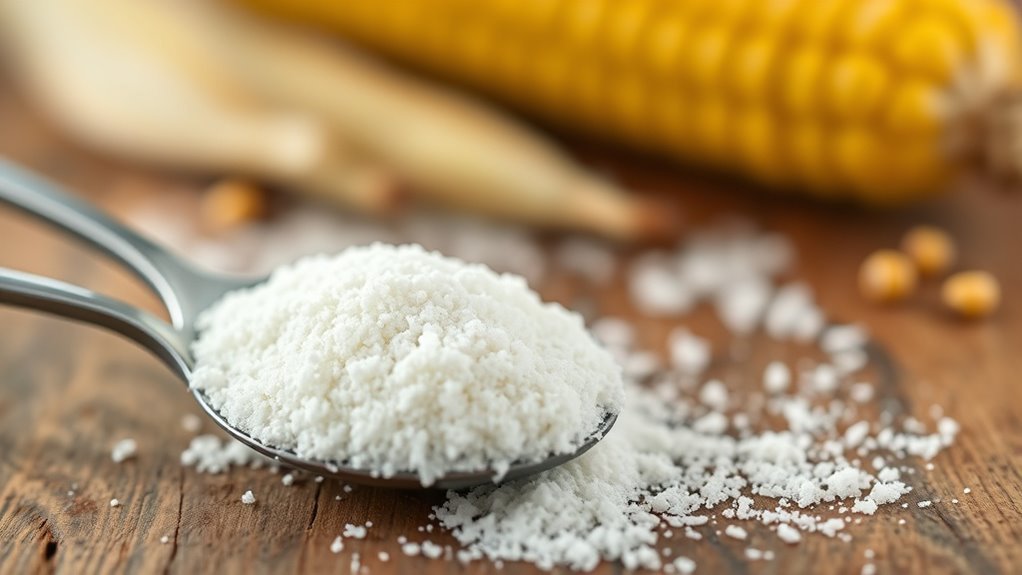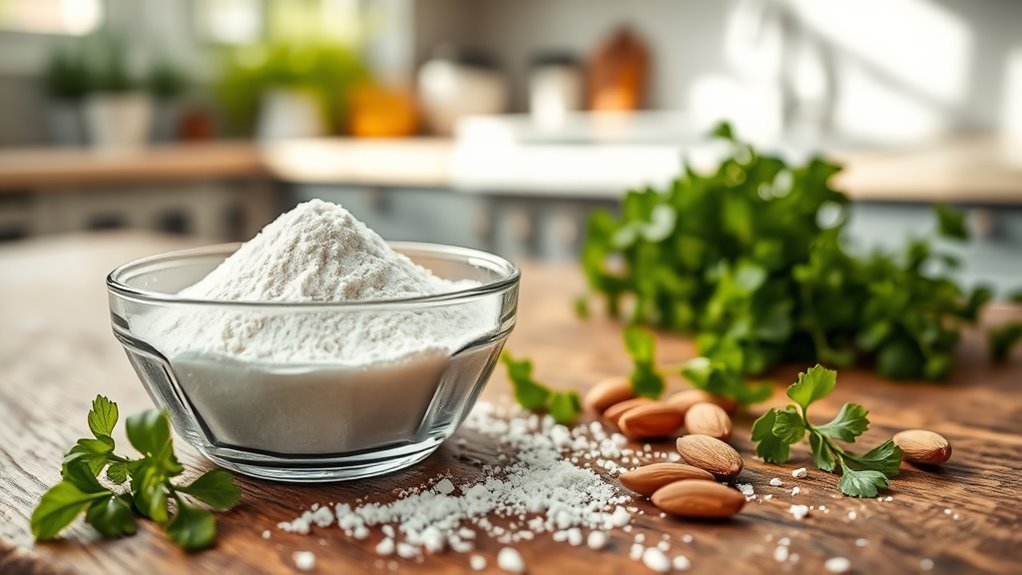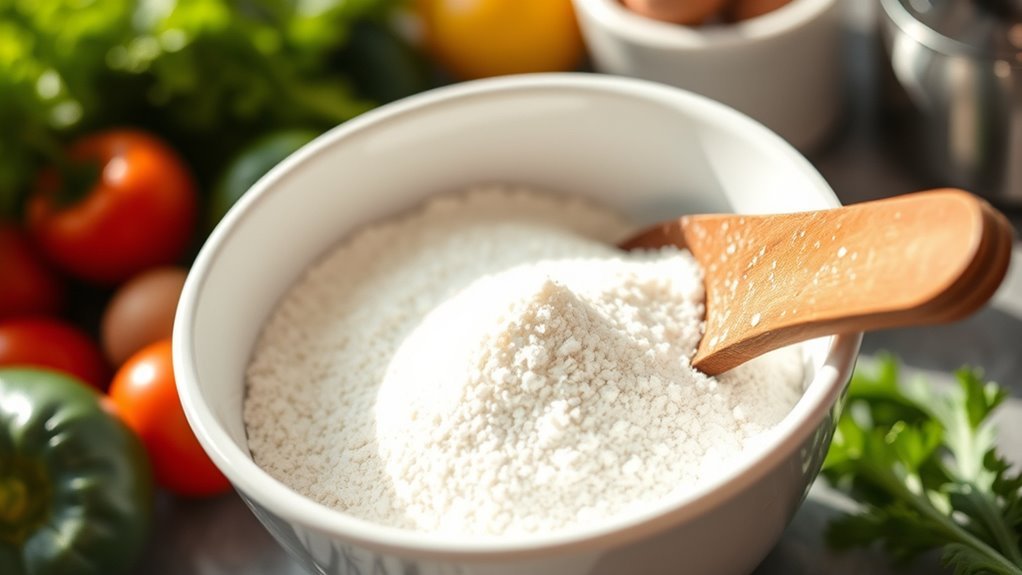Cornstarch isn’t suitable for a keto diet due to its high carbohydrate content, which can interfere with reaching ketosis. With about 7 grams of carbs per tablespoon, it can quickly add up and spike blood sugar levels. Instead, consider low-carb alternatives like almond flour or xanthan gum for thickening. By choosing the right substitutes and practicing portion control, you can stay on track with your keto goals. There’s more to discover about effective ingredient choices and maintaining ketosis.
Understanding Cornstarch and Its Nutritional Profile

Cornstarch, a common thickening agent derived from corn, plays a significant role in cooking and baking. It’s valued for its ability to create smooth textures in sauces and puddings. While it does offer some nutritional benefits, such as being gluten-free and low in fat, it’s primarily composed of carbohydrates, which may not align with your dietary goals if you’re pursuing a keto lifestyle. If you’re looking for cornstarch alternatives, consider options like almond flour, xanthan gum, or arrowroot powder. These substitutes can provide similar thickening properties without the high carb content, allowing you to maintain your desired nutritional balance. Choosing the right alternative can help you achieve culinary satisfaction while staying true to your dietary preferences.
Carbohydrate Content and Its Impact on Ketosis

When considering cornstarch on a keto diet, it’s vital to look at its carbohydrate content. Typically, cornstarch is high in carbs, which can disrupt your state of ketosis if consumed in excess. Understanding how these carbs impact your body is essential for maintaining your ketogenic goals. The glycemic index of cornstarch is around 70, causing rapid blood sugar spikes that can interfere with ketosis.
Cornstarch Carb Count
Understanding the carb count in cornstarch is essential for anyone following a keto diet. Cornstarch contains about 7 grams of carbs per tablespoon, which can quickly add up if you’re trying to maintain ketosis. If you’re looking for cornstarch substitutes, consider options like almond flour or coconut flour, which are more keto-friendly. Additionally, balancing intake with low-carb foods supports ketosis and can enhance your overall dietary success.
Here’s a quick comparison:
| Ingredient | Carbs (per tablespoon) | Keto Friendly |
|---|---|---|
| Cornstarch | 7g | No |
| Almond Flour | 1g | Yes |
| Coconut Flour | 6g | Yes |
| Psyllium Husk | 0g | Yes |
| Flaxseed Meal | 0g | Yes |
Choosing these keto-friendly options can help you stay within your carb limit while still enjoying cooking and baking.
Ketosis and Carbs
Achieving and maintaining ketosis hinges largely on your carbohydrate intake. To stay in ketosis, you typically need to limit your daily carbs to around 20-50 grams, aligning with keto principles. This restriction encourages your body to burn fat for fuel instead of glucose. However, some people practice carb cycling, allowing for higher carb days strategically to replenish glycogen stores without completely disrupting ketosis. It’s vital to listen to your body; not everyone reacts the same way to carbohydrate consumption. If you’re considering including foods like cornstarch, remember that it’s high in carbs and could kick you out of ketosis. Balancing your carb intake is essential for freedom and flexibility in your diet while pursuing your health goals. Additionally, understanding hidden carbs can help you make better food choices and maintain your desired ketone levels.
Alternatives to Cornstarch on a Keto Diet

While cornstarch is often a go-to thickening agent in many recipes, those following a keto diet need to find suitable alternatives that align with their low-carbohydrate lifestyle. Keto flours like almond flour and coconut flour can work well, though they may not thicken liquids as effectively. For a more direct substitute, consider using xanthan gum or guar gum, both of which are low in carbs and highly effective as thickening agents. Just a small amount can achieve the desired consistency without adding significant carbs. Another option is psyllium husk powder, which can also help in thickening while providing fiber. By experimenting with these alternatives, you can maintain the texture of your dishes without compromising your keto goals. Additionally, monitoring your carbohydrate content is crucial to stay within your daily limits.
How to Use Cornstarch Sparingly
When using cornstarch on a keto diet, it’s essential to contemplate low-carb recipe substitutes that can maintain texture without adding too many carbs. You can also practice portion control techniques to keep your intake minimal while still enjoying your favorite dishes. By being mindful of how you incorporate cornstarch, you can strike a balance that works for your dietary goals.
Low-carb Recipe Substitutes
Although cornstarch is often a staple in traditional cooking, it can pose challenges for those following a keto diet due to its high carbohydrate content. Luckily, you can still achieve similar textures and consistency in your dishes by using low-carb alternatives. Here are some substitutes that work well for keto baking:
| Substitute | Usage Ratio |
|---|---|
| Almond Flour | 1 cup = 1/4 cup cornstarch |
| Coconut Flour | 1 cup = 1/3 cup cornstarch |
| Psyllium Husk | 1 cup = 1 tablespoon cornstarch |
| Xanthan Gum | 1 cup = 1 teaspoon cornstarch |
| Flaxseed Meal | 1 cup = 1/4 cup cornstarch |
These low-carb flours can help you maintain your keto lifestyle while enjoying your favorite recipes! Additionally, incorporating high-quality protein sources like brisket’s nutritional profile supports muscle maintenance and satiety on a keto diet.
Portion Control Techniques
Managing your portion sizes is essential for incorporating cornstarch into your diet without exceeding your carb limits. Here are some portion control techniques to practice mindful eating:
- Measure Carefully: Use a kitchen scale or measuring spoons to determine the exact amount of cornstarch you’re using. This helps you stay aware of your carb intake.
- Dilute with Low-Carb Ingredients: Mix cornstarch with low-carb ingredients in your recipes. This way, you can enjoy the texture without overwhelming your diet.
- Limit Frequency: Reserve cornstarch for special occasions or recipes that truly require it. This keeps your overall carb count in check while still allowing for occasional indulgence.
Recipes Incorporating Low-Carb Thickening Agents
While shifting to a keto diet, you might find yourself seeking alternatives to traditional thickening agents like cornstarch, which can be high in carbohydrates. Instead, consider using options like xanthan gum or guar gum, both of which are low in carbs and effective for thickening. These agents can help you create delicious low carb sauces and enhance the texture of keto friendly soups without sacrificing flavor. For a simple low carb sauce, whisk together broth, xanthan gum, and your favorite herbs. For soups, blend cooked vegetables and thicken with guar gum for a creamy consistency. Embracing these alternatives can offer you the freedom to enjoy satisfying meals while staying true to your keto lifestyle. Additionally, many people on keto find high carbohydrate content in traditional thickeners can disrupt their diet goals.
Monitoring Your Ketosis Levels
To guarantee you’re effectively following a keto diet, monitoring your ketosis levels is essential. Understanding your body’s ketone production can empower your journey. Here are three methods for effective ketosis monitoring:
- Blood ketone testing: This is the most accurate method, measuring the level of ketones in your blood. Aim for a range of 0.5 to 3.0 mmol/L for ideal ketosis.
- Urine strips: An accessible option, these strips measure acetoacetate in urine. While less accurate than blood tests, they can still provide insights, especially for beginners.
- Breath analyzers: These devices measure acetone levels in your breath. While convenient, results can vary, so consider them supplementary. Staying hydrated is also important as it supports overall well-being during your keto journey.
Making Informed Choices for Your Keto Journey
How can you make informed choices on your keto journey? Start by understanding the nutritional content of your meals. Each keto meal should prioritize high-quality fats and low-carb vegetables. Instead of traditional thickening agents like cornstarch, consider ingredient swaps such as almond flour or xanthan gum, which can keep your carb count in check while still achieving the desired texture. Researching recipes and reading food labels will empower you to make smart decisions. Don’t be afraid to experiment with new ingredients that fit your lifestyle. Remember, keto is about personal freedom to choose what works for you, so stay informed and flexible. Knowledge is your ally in maintaining a successful, enjoyable keto lifestyle. Additionally, being aware of carbohydrate content in foods like potatoes can help you avoid disrupting ketosis.
Frequently Asked Questions
Can I Use Cornstarch in Keto-Friendly Desserts?
You can’t use cornstarch in keto-friendly desserts if you’re aiming to keep it low carb. Cornstarch is high in carbs and doesn’t fit well with keto principles. Instead, consider keto dessert alternatives like almond flour or coconut flour. For thickening, low carb thickeners such as xanthan gum or psyllium husk can be great substitutes. They’ll help you achieve that desired texture without compromising your carb limits, allowing for more freedom in your dessert creations.
How Does Cornstarch Affect Blood Sugar Levels?
Cornstarch can greatly affect blood sugar levels, causing a rapid rise due to its high carbohydrate content. When you consume it, your body releases insulin to manage this spike, which might not align with your keto goals. It’s important to monitor your insulin response if you’re considering using cornstarch, as it could lead to cravings or energy crashes. Balancing your choices with low-carb alternatives can provide more stable blood sugar control.
Is Cornstarch Safe for People With Gluten Intolerance?
Imagine traversing a maze, searching for safe pathways—this is how people with gluten intolerance feel. Cornstarch can be a safe option, as it’s naturally gluten-free, making it a viable choice among gluten alternatives. However, if you’re sensitive, it’s wise to test your tolerance. For those seeking cornstarch substitutes, consider arrowroot or tapioca flour, which also serve as great thickening agents, allowing you to enjoy your meals without worry. Always read labels for assurance!
Can I Substitute Cornstarch for Other Thickeners?
Yes, you can substitute cornstarch with several effective thickening agents. Common cornstarch alternatives include arrowroot powder, tapioca starch, and potato starch. Each has unique properties—arrowroot works well in acidic dishes, while tapioca gives a glossy finish. Remember, these substitutes may require different ratios, so adjust accordingly. Experimenting with these alternatives can give you the freedom to achieve the desired consistency in your recipes, all while maintaining a balanced approach to your cooking.
What Are the Long-Term Effects of Using Cornstarch on Keto?
If you’re considering cornstarch on keto, you should know the long-term health hazards it might pose. Cornstarch can spike blood sugar levels, potentially leading to unwanted metabolic effects over time. While it may seem tempting for thickening, relying on it could compromise your keto goals. Opting for alternatives like xanthan gum or chia seeds might better support your metabolic journey, giving you the freedom to enjoy a balanced diet without unwanted consequences.


